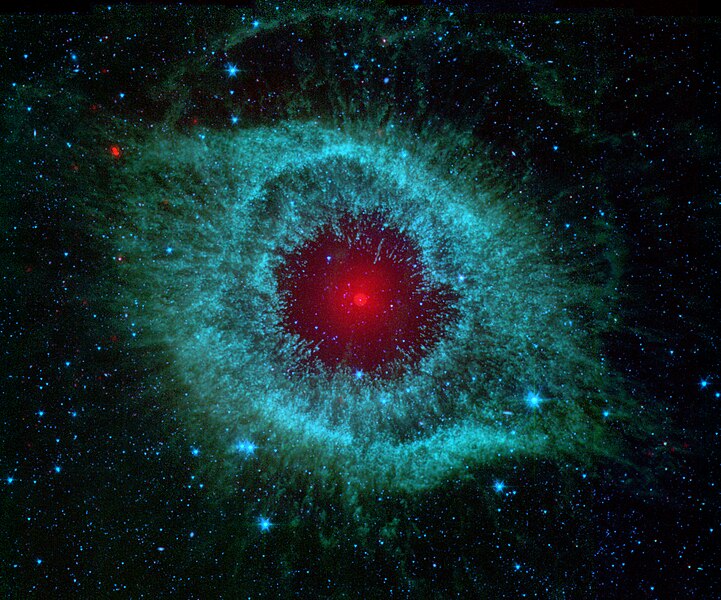Fichier:Comets Kick up Dust in Helix Nebula (PIA09178).jpg
Ausgesinn

Gréisst vun dëser Duerstellung: 721 × 600 Pixel. Aner Opléisungen: 289 × 240 Pixel | 577 × 480 Pixel | 923 × 768 Pixel | 1.231 × 1.024 Pixel | 2.462 × 2.048 Pixel | 4.279 × 3.559 Pixel.
Original-Fichier (4.279 × 3.559 Pixel, Fichiersgréisst: 7,22 MB, MIME-Typ: image/jpeg)
Versiounen
Klickt op e bestëmmten Zäitpunkt fir déi respektiv Versioun vum Fichier ze kucken.
| Versioun vum | Miniaturbild | Dimensiounen | Benotzer | Bemierkung | |
|---|---|---|---|---|---|
| aktuell | 03:43, 13. Feb. 2007 |  | 4.279 × 3.559 (7,22 MB) | Startaq | {{Information |Description=This infrared image from NASA's Spitzer Space Telescope shows the Helix nebula, a cosmic starlet often photographed by amateur astronomers for its vivid colors and eerie resemblance to a giant eye. The nebula, located about 700 |
Benotze vu Fichieren
Dës Säite benotzen dëse Fichier:
Globaalt Benotze vum Fichier
Dës aner Wikie benotzen dëse Fichier:
- Benotzt op af.wikipedia.org
- Benotzt op ar.wikipedia.org
- Benotzt op arz.wikipedia.org
- Benotzt op ast.wikipedia.org
- Benotzt op ba.wikipedia.org
- Benotzt op bg.wikipedia.org
- Benotzt op bjn.wikipedia.org
- Benotzt op bn.wikipedia.org
- Benotzt op br.wikipedia.org
- Benotzt op ca.wikipedia.org
- Benotzt op cs.wikipedia.org
- Benotzt op de.wikipedia.org
- Benotzt op dsb.wikipedia.org
- Benotzt op en.wikipedia.org
- Helix Nebula
- Spitzer Space Telescope
- Comet nucleus
- Talk:Helix Nebula
- User:Swirlex/Userboxes
- User:Swirlex/Userboxcode
- NASA
- Wikipedia:Featured pictures/Space/Looking out
- User:Nonexyst
- User:Benjamin112
- Portal:Outer space/Selected picture
- User:Sunfishtommy/sandbox
- Wikipedia:Featured pictures thumbs/44
- Wikipedia:Featured picture candidates/October-2014
- User talk:Benison/Archive 19
- Wikipedia:Featured picture candidates/The God's Eye
- Wikipedia:Picture of the day/October 2016
- Template:POTD/2016-10-12
- Wikipedia:Main Page history/2016 October 12
- User talk:69.50.70.9
- User:The NMI User
- User:Corinne/subpage
- User talk:Benison/Archive 37
- Wikipedia:Userboxes/Science/Astronomy
- User:Catfurball
- User:Huggums537
Kuckt globale Gebrauch vun dësem Fichier.




